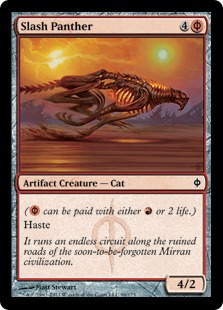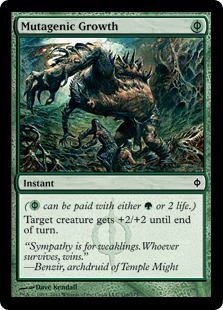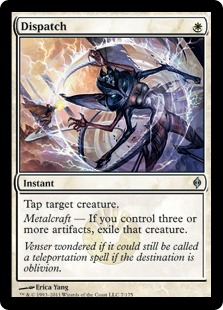I’m writing this from my dad’s house in Massachusetts, where I’m visiting for the week prior to the StarCityGames.com Boston Open.
I’ve been largely disconnected from what’s going on in the Magic world, as I’ve spent my days exploring the town where I grew up in
New Hampshire and visiting with old friends from way back when (not to mention trying and failing to buy an iPad 2 at the sales-tax-free Rockingham
Mall). I did still have my phone with me, though, and I couldn’t help but notice the sudden surge of posts on Twitter talking about all kinds of
new cards.
As most of you are certainly aware, the past week or so has marked a WikiLeaks-scale batch of spoilers from New Phyrexia. The first trickle came from a
Japanese site, including Karn and the Phyrexian mana mechanic, but the real floodgates opened a few days ago when the entire “godbook” for
the set was posted in PDF form online.
Spoiler times are always exciting times for Magic players, but I can’t help but feel a little disappointed by the way things happened this time
around. Wizards has been remarkably successful in recent years at keeping sets under wraps up until they release all of the information themselves, and
with how tightly they kept the lid on even the name of the third set in Scars block, it looked like that pattern was set to continue. The Japanese leak
was relatively small scale and was just enough to get players excited by the new mechanics and a few cool cards. The godbook leak, though, was just too
much too fast—it really kills the anticipation that WotC wants to build up using carefully timed spoilers, both on the Mothership and on
third-party sites.
It’s many of those sites that are really hit the hardest by this leak. While StarCityGames.com certainly won’t suffer due to missing out on
exclusive spoilers, smaller fan sites really benefit from the traffic they get during spoiler season. With the full set spoiled so far in advance,
players will have much less incentive to visit those sites when their articles go up. So while it might seem cool to have the whole set so far in
advance, keep in mind that these kinds of leaks are, ultimately, a bad thing for Magic. Wizards has very good reason for their preview process, and
those rogue translators or whoever it might be who violated their NDAs and posted this information deserve whatever legal repercussions that they get
from all of this.
 However, we can’t just pretend that the cat isn’t out of the bag. The spoiler is out there, and for those of us in the Pro Magic community,
However, we can’t just pretend that the cat isn’t out of the bag. The spoiler is out there, and for those of us in the Pro Magic community,
we’d be doing ourselves a disservice if we tried to keep our experience “pure” by avoiding it. Anyone going to GP Providence or PT
Nagoya would be giving up an edge to the competition, to say nothing of the desire to just stay reasonably well-informed, by not participating in
conversations about the new set.
That
said, I’m not going to dissect the entire spoiler just yet—there’s still a great deal of time left for that. But I do want to touch
on some of the cards that stood out most to me.
All of the cards involving Phyrexian mana are very interesting. Understanding the relative value of resources and their exchange is one of the most
important skills for a Magic player to develop, and seeing WotC make a mechanic that revolves around such exchanges into a cornerstone of the set will
thrust that into focus. Is it worth two life to shave a mana off the cost of a card? Or to dip into another color’s territory for an effect that
you wouldn’t otherwise be able to play? Phyrexian mana, and the proper use of it, will certainly be a topic of much debate as New Phyrexia enters
the tournament scene.
There’s a major chasm in the different ways that Phyrexian mana can be used in the set. One of those ways—as seen on Slash Panther and many
other cards—is to provide some partial discount on the card’s cost, along with avoiding colored mana requirements. The other way involves
making the entire casting cost of the card payable with Phyrexian mana, which allows it to be cast without any mana at all.
On the surface, these are the same—they use the same mechanic, and they both provide the same options to the player of “pay X or 2
life,” but in practice, they’re quite different. The difference between zero mana and one mana is the biggest jump in cost in the game, and
the implications of free spells are enormous. I’m not even talking about juicing up storm counts in Legacy or anything like that. In fact,
I’m talking about that purist of all Magic formats—Limited.
“I wonder if I’m going to hate Mutagenic Growth as much as I hated Zombie Cutthroat” @bmkibler
 That was my first reaction on Twitter upon seeing the New Phyrexia mechanics article. I loved Onslaught block, and in particular, I
That was my first reaction on Twitter upon seeing the New Phyrexia mechanics article. I loved Onslaught block, and in particular, I
loved the morph mechanic. The puzzle of trying to piece together what an opposing morph might be based on my opponent’s lines of play was
incredibly satisfying to me, and I felt like I had a preternatural ability to block Skirk Commandos and let Battering Craghorns through. There were so
many factors to consider when deducing opposing morphs, from the order they played them to what land they kept up at various points in the game to
minor pauses and other visual cues. The morph mechanic made Onslaught/Legions draft my favorite Limited format for a long time (the fact that I won a
GP in the format didn’t hurt either).
Then came Scourge, and with it, Zombie Cutthroat.
Zombie Cutthroat ruined the morph game for me. There was no longer an intricate, multi-layered puzzle about what the opposing morph could be and the
best course of action based on the various possibilities. There was always, at any moment, no matter what color your opponent was playing or what mana
they had up, the possibility that you could be throwing your creature headlong into a Zombie Cutthroat.
Mutagenic Growth has that same stink to it. It’s a card that you’re going to have to wonder if you can play around no matter what.
Your opponent is playing mono-blue, and he’s completely tapped out? GOTCHA! Your opponent plays a Blackcleave Goblin turn 4 and sends it into
your superior team. Don’t block? GOTCHA GOTCHA GOTCHA GOTCHA YER DEAD!
The thing I hated about Zombie Cutthroat—and the thing I feel I’m probably going to hate about Mutagenic Growth—is that it’s
something you always have to be worried about. There’s something that feels safe about sitting across from a tapped-out opponent. All of your
decisions should be that much easier because you don’t have to worry about what your opponent might be able to do. With Mutagenic Growth in the
mix, a diligent player will have to consider its impact on virtually every turn of every game.
The extreme end of the spectrum of free combat tricks is VS System. For the sake of any one who didn’t play it, VS System had Plot Twist cards
that functioned much like instants in Magic. Because the entire game was funneled through the axis of character combat, most Plot Twists were combat
tricks of some kind. Unlike in Magic, however, Plot Twists didn’t use the same resource system as the characters in the game. They used a
threshold costing system, which meant that you couldn’t play them until you had a number of resources equal to their threshold cost, but when you
met that condition, you could play as many of them as you wanted.
Sensing any problems here? On, say, turn 4 of a game of VS, a player had to decide what kind of attacks he wanted to make and before doing so had to
calculate all of the possible permutations of Plot Twists his opponent might be able to play, as well as all of the possible Plot Twists he might be
able to play himself in response. VS System had no “tapped-out” state, so there was never a time when all of the possible outcomes of a
turn could be determined from the board alone. As a result, tournament VS games often proceeded at an absolutely glacial pace, to the point that VS
events had to go to one-game matches in order to be able to run events with any reasonable number of rounds—and even then, a large number of
matches would go to extra time.
Magic isn’t VS, and the existence of Mutagenic Growth is a far cry from having an entire class of cards without functional costs. But it
introduces much the same dilemma that VS faced, which is the fact that the “tapped out” state, which dramatically simplifies player
decisions, is gone. “What if he has Mutagenic Growth here?” is something players are going to have to stop and ask themselves constantly
while playing New Phyrexia Limited, and that sucks.
That said—I’m glad Mutagenic Growth exists. I think Phyrexian mana is really cool, and I realize that pushing its boundaries to make cards
like Mutagenic Growth really appeals to a certain segment of the Magic player base. Those very “GOTCHA” moments that I bemoaned a few short
paragraphs back are exactly the kinds of things a lot of players like, and while I feel like the overall impact of Mutagenic Growth on competitive
Limited play will be negative for top players, those players who love “GOTCHA” moments sure as hell buy a lot more cards than I do.
I’ll suck it up and resign myself to hating it so they can have their fun.
I don’t have nearly as much to say about any other cards in the set, but there were a few others that caught my eye. The first place I look in
most sets is the cheapest cards because finding the best deals mana-wise is so key with how the economy is in Dominaria these days. Dispatch, the
twiddle-turned-Path to Exile, is the first card to come around that makes metalcraft look really enticing.
Unlike Galvanic Blast and Stoic Rebuttal, which have both seen play in large part because they’re fine without metalcraft, Dispatch goes from an
extremely weak effect to a very strong one—is it worth working toward? There’s already a lot of competition for cheap white removal these
days, but most of it is really geared toward control decks, with cards like Oust and Condemn. I’d be interested to see if Dispatch—along
with some of the new Phyrexian mana artifact creatures—gives Tempered Steel decks that extra punch they need.
Despise
B
Sorcery
Target opponent reveals his or her hand. You choose a creature or planeswalker card from it. That player discards that card.
One of the most interesting cards in the new set to me is Despise. In addition to an awesome name, Despise has the distinction of being able to force
an opponent to discard any of Stoneforge Mystic, Squadron Hawk, or Jace, the Mind Sculptor. The previous discard mix of Inquisition and Duress meant
each card was an either-or, but I have to wonder how Despise might shake things up. Either Inquisition or Duress can hit Sword of Feast and Famine or
Mana Leak, which Despise cannot, but Despise nails every major card in RUG, which neither Inquisition nor Duress can lay claim to. A single card that
can nab Lotus Cobra, Inferno Titan, or Jace? Sign me up. I’m not sure what sort of discard mix will ultimately turn out to be preferable come New
Phyrexia time, but I have a feeling Despise will be part of it.
I could go on about a bunch more cards, but there will be ample time for that—the set’s release is still almost a month away! I
haven’t quite gotten to brewing NPH decks just yet, either—I still have the StarCityGames.com Open in Boston to win this weekend in the
current formats! But after that… let the brewing begin!
Until next time,
bmk

